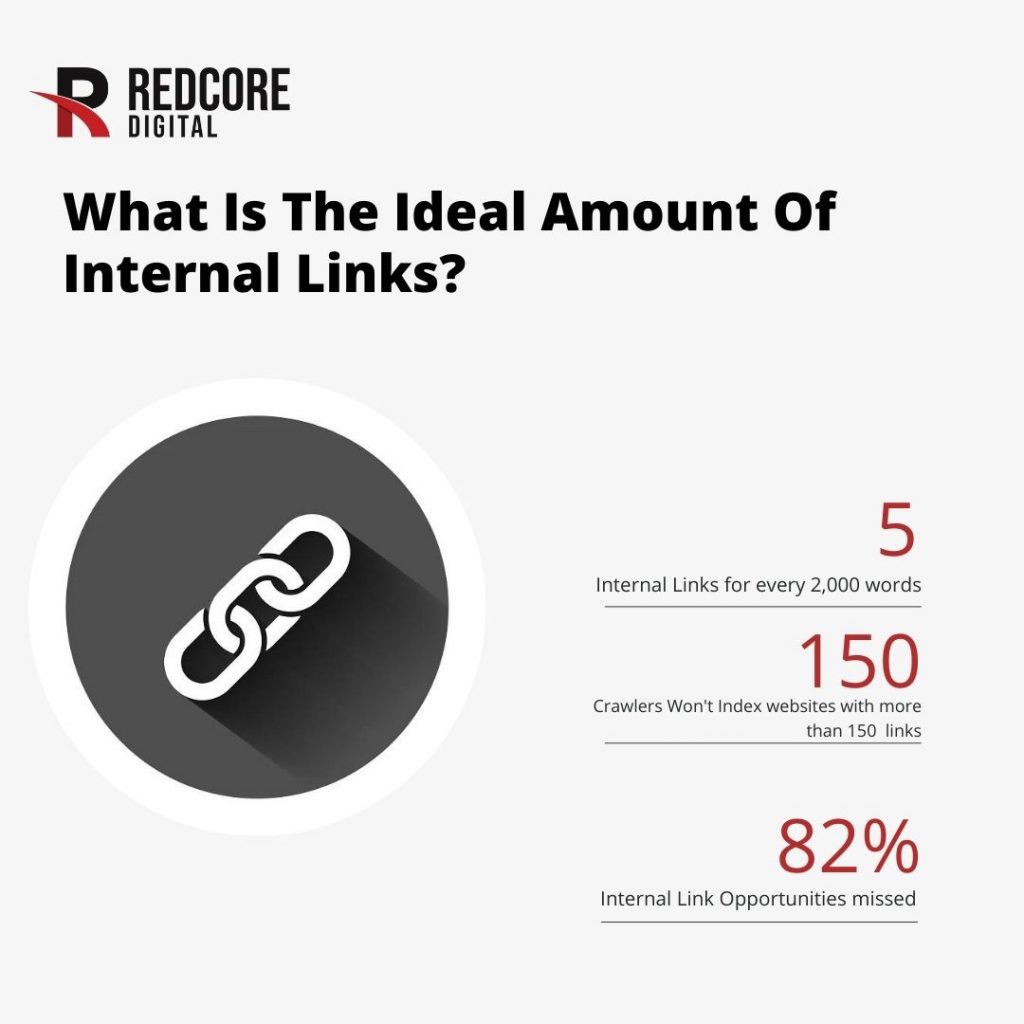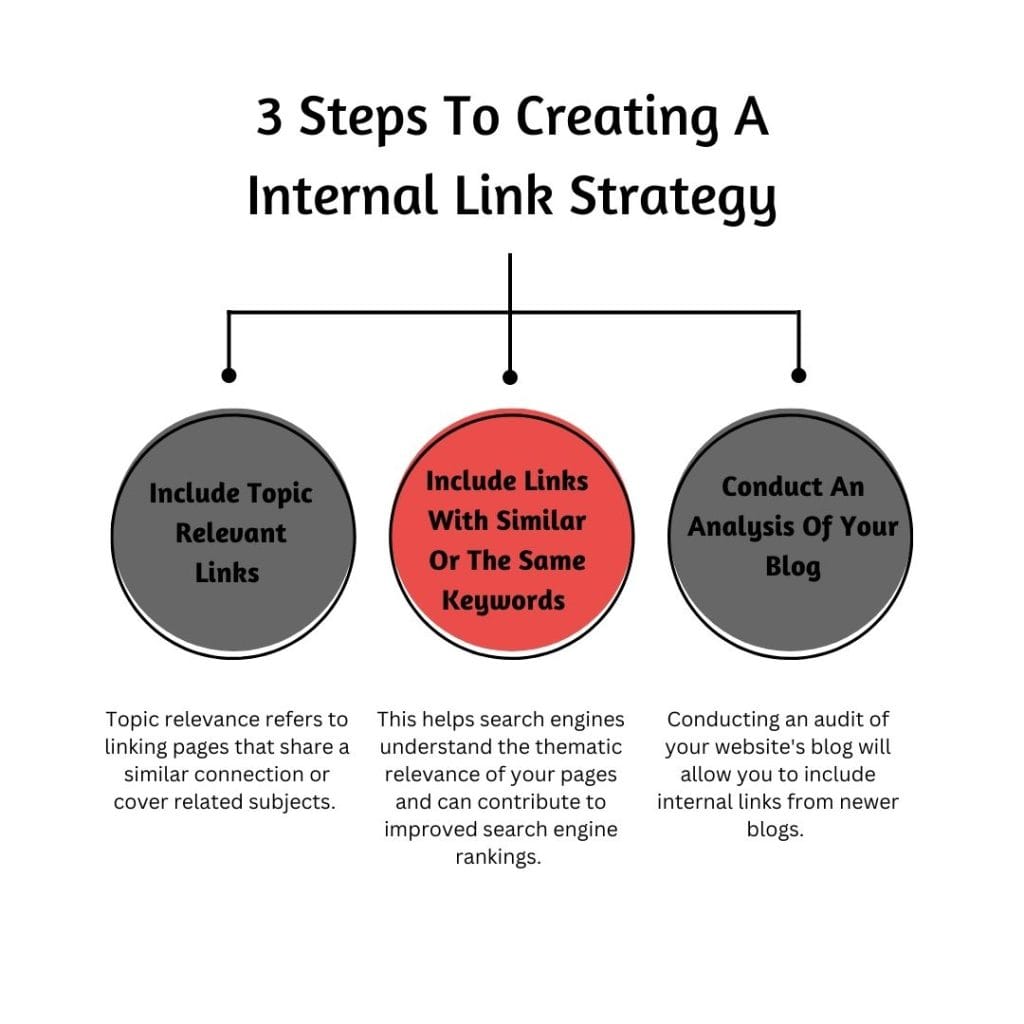What Are Internal Links?
An internal link is a link used on a website to refer back to information that can assist a user in their search for information.
For example, if you’ve written a blog about “The Importance of copywriting in SEO” then you would include internal links to the following
- SEO service page
- Other copywriting blogs
- Blogs created about other technical SEO
- Additional topics or services you may have mentioned throughout.
Internal links allow businesses to increase the likelihood of a user continuing on the site due to interest in the other information linked throughout the posts.
Why Do We Use Internal Links In SEO?
Internal links are used widely within the digital marketing field as it’s a way to assist with..
- Conversions
- Website Traffic
- Authority
- Knowledge
- Expertise
- Help & Advice
- Inquiries
- Conversions
- SEO Ranking
Internal links play a crucial role in SEO as they enhance website navigation and improve user experience.
By strategically incorporating internal links throughout a website, search engines can crawl and index pages more effectively, leading to better visibility and higher rankings.
Internal links also help establish the hierarchy and structure of a website, guiding visitors to relevant content and increasing their engagement.
Internal links distribute link equity, also known as Page Rank.
This means boosting the authority and visibility of important pages within a website.
Overall, implementing well-placed internal links not only supports SEO efforts but also aids users in discovering valuable information within a website.
How Important Is Internal Linking In SEO?
Without internal linking you would be sacrificing perfectly good content, this means that by not linking to previous work the likelihood a user will locate it decreases significantly.
This has a negative impact on your business as your losing valuable time creating work that has a decreased chance of being read.
Without including internal links you are decreasing the chances of ranking highly within the SERP.
Internal links serve as contextual cues for website crawlers.
These crawlers typically have limited knowledge about your site prior to scanning it, so the inclusion of relevant information through internal links helps them understand your intended ranking goals.
Incorporating internal links aligns with your website’s purpose. For instance, if your website represents a supermarket.
Posting about the latest digital marketing trends would be irrelevant to your audience and business.
Making it crucial to include internal links that benefit both your target audience and your business objectives.
What Is The Ideal Amount Of Internal Links?
SEO best practice suggests that for every 2,000 words written, you should aim to include 5 internal links.
A website crawler won’t crawl pages including 150 internal links or more.

Internal link stuffing refers to the practice of excessively and pointlessly adding numerous internal links within the content.
Often with the intent of manipulating search engine rankings.
However, this strategy can have detrimental effects on both user experience and SEO.
Excessive internal link stuffing can overwhelm and confuse website visitors, hindering their ability to navigate the site and find relevant information.
It can also dilute the value of individual internal links, making it difficult for search engine crawlers to determine the significance and relevance of specific pages.
Search engines may view excessive internal link stuffing as a manipulative tactic, resulting in penalties or a decrease in rankings.
It is crucial to maintain a balanced and purposeful approach to internal linking to avoid these negative consequences.
Benefits Of Internal Links In SEO
There are numerous benefits to including internal links when publishing on a website so, let’s take a look at some.
1. Establish Relevance
As we’ve discussed throughout this blog it’s detrimental that both the user and the crawler understand the relevance of this content to your site overall.
Without being able to establish relevant content it may lead to a bad reputation for your business or a poor user experience.
Establishing relevance when including internal links in website content is crucial as it ensures that the linked pages are contextually related to the anchor text and the overall topic.
Providing valuable information to users. By maintaining relevance, internal links enhance user experience.
Increase engagement and improve the credibility and authority of the website in the eyes of search engines.
2. Increase Website Traffic
Internal links play a crucial role in increasing website traffic.
They are links that connect different pages within the same website.
Internal links can lead users to additional pages and content they may find interesting or helpful.
By guiding visitors to related articles or resources, you encourage them to view multiple pages within your website.
Internal links can help reduce bounce rates by keeping users engaged and encouraging them to explore additional content.
Internal links also provide SEO (Search Engine Optimisation) benefits.
When search engines crawl your website, they follow internal links to discover and index your content more effectively.
This leads to more traffic as your post is higher on the SERP meaning more users are more likely to reach your website.
3. Assist Search Engines in Locating Content
Internal links help search engine crawlers understand the structure and hierarchy of your website.
By linking to important pages from your homepage or other high-ranking pages, you signal to search engines that those pages hold significance and should be indexed and considered for search rankings.
By using anchor text (the clickable text of a link) that includes relevant keywords, internal links provide additional context to search engines about the content of the linked pages.
Also known as Keyword relevance, ensuring the relevant and important words are included to help both the user and the crawler to better understand a site.
This can help search engines understand the relevance of your pages to specific search queries and improve their visibility in search results.
Creating An Internal Link Strategy
Include Topic Relevant Links
When creating an internal link strategy, it is crucial to include topic-relevant links.
Topic relevance refers to linking pages that share a similar connection or cover related subjects.
By incorporating topic-relevant links, you enhance the user experience by guiding visitors to additional content that is directly related to their interests or needs.
Search engines value topic relevance as it helps them understand the context, theme and focus of your website.
By linking pages that share a common theme, you demonstrate the depth and breadth of your content to both users and search engines.
This helps to improve your website’s overall visibility and authority.
Therefore, when devising an internal link strategy it’s important to prioritise the inclusion of topic-relevant links to provide value to your users and enhance your website’s search engine optimisation.
Include Links With Similar Or The Same Keywords
When creating an internal link strategy, it is important to include links with similar or the same keywords.
By incorporating internal links that use relevant keywords, you provide additional context to both users and search engines about the content of the linked pages.
This helps search engines understand the thematic relevance of your pages and can contribute to improved search engine rankings.
Including consistent keywords in your internal links enhances the user experience by guiding visitors to related content that aligns with their search intent.
When users encounter links with familiar keywords, they are more likely to click on them, leading to increased engagement and longer website visits.
Therefore, including links with similar or the same keywords within your internal link strategy is a valuable technique for improving SEO.
Conduct An Analysis Of Your Blog
It’s crucial when creating a new or improved internal link strategy that you conduct an audit on your existing blog post on your website.
Conducting an audit of your website’s blog will allow you to include internal links from newer blogs.
Creating blogs is greate but remember the main purpose of blogs in SEO is to provide knowledge, expertise and authority.
Making sure you consistently update your new and existing blogs for internal link opportunities is key.
Without conducting regular updates and audits you are limiting the ability of your blog posts.
analysing your blog allows you to identify any gaps or areas where internal linking can be improved to provide a more cohesive and comprehensive user experience.

Is Copywriting Integral For SEO & Including Internal Links?
Copywriting is a great way to ensure you can include internal links in your website.
Similarly to what was mentioned above that the main reason for blog posts and copywriting in SEO portray knowledge, authority and expertise.
Copywriting involves creating persuasive and compelling content that not only engages readers but also optimises your website for search engines.
When it comes to SEO, well-written copy that incorporates relevant keywords provides valuable information and encourages user engagement is highly beneficial.
Including internal links within your copy is an important SEO tactic
Here a RedCore we enjoy writing blogs as well as the benefits they bring to our website.
One of the most relevant points throughout this blog is to ensure you are consistently reviewing and improving your internal links, especially when creating compelling copy for your audience as it will hopefully entice them to continue reading,













